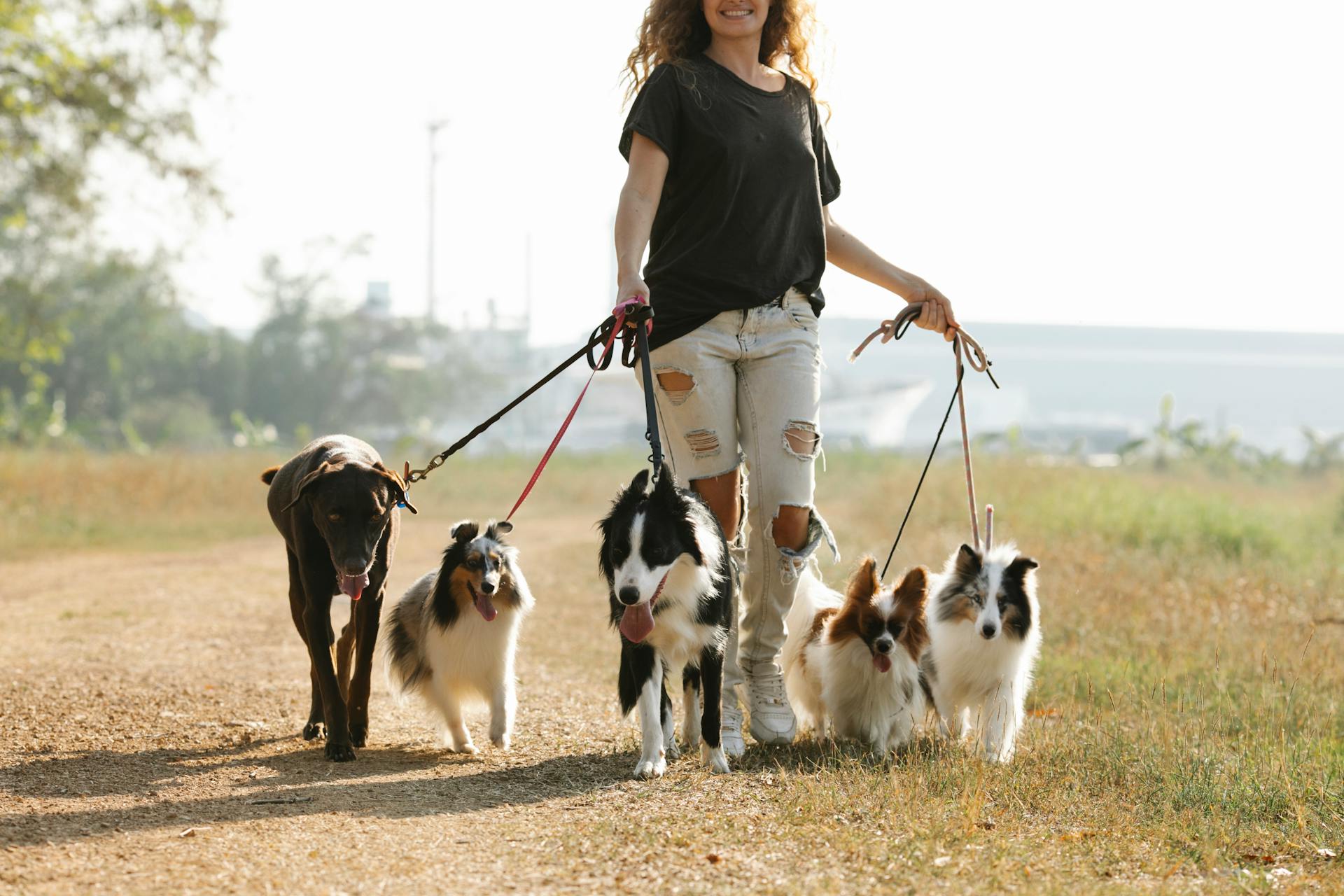
Leash pulling is one of the most common issues dog owners face, and it's not just about the dog being stubborn. In fact, studies show that up to 90% of dogs exhibit leash pulling behavior at some point in their lives.
The good news is that leash pulling is a learned behavior, and with consistent training, it can be unlearned. This means that even if your dog has been pulling on the leash for years, it's never too late to start training.
To begin with, it's essential to understand why dogs pull on the leash in the first place. One reason is that they're naturally inclined to follow their noses, and with all the interesting smells and sights around them, it's no wonder they get distracted.
Check this out: Dog Training Harness for Pulling
Preparation and Basics
To start training your dog to walk nicely on a leash, you'll need the right equipment and approach. A reward-oriented approach is key, as the American Kennel Club supports training that reinforces good behavior.
You'll need a few basic tools: a collar or harness, a leash (4-foot or 6-foot length, not retractable), and treats. The type of collar or harness you choose is up to you, but options like a buckle collar, Martingale, head halter, or front-clip harness can be effective.
To begin, fill your pocket or treat pouch with treats. Decide which side you'd like your dog to walk on, and hold a few treats on that side of your body. This will help your dog learn to associate walking on that side with rewards.
A leash with a "J" shape is ideal, as it allows your dog to walk beside you while keeping the leash loose. Hold the leash in the hand opposite your dog, and let the rest of it hang loosely.
Here are some essential steps to get you started:
- Take a step, then stop. Feed your dog a treat from your hand, in line with the seam of your pants.
- Repeat this process, taking two steps instead of one before stopping and feeding your dog.
- If your dog pulls ahead, stop walking immediately and call them back to your side.
- Gradually take more steps between each treat, and use verbal cues to keep your dog's attention on you.
Remember, the goal is to teach your dog that walking on a loose leash is a positive behavior that gets them rewards. With patience and consistency, you can help your dog learn to walk nicely on a leash.
Training Techniques
Leash training a puppy to heel is useful for short periods when you need him very close to you and attentive to you. It can be very helpful when walking him past distractions like other animals.
Begin by practicing in your home with a treat in your fist. Say "let's go" and take a couple of steps while leading him along with the treat in your fist near your thigh. Praise and reward him with a treat when he is following your fist with his nose.
Stop moving forward when he pulls on the leash, and reward him with treats when he walks by your side. A treat bag for your waist can be very helpful in the training process.
To challenge your dog during leash training, outfit him in a standard harness attached to a 6-foot leash. Toss a ball or treat 20-feet away from you and your leashed dog. If he pulls toward the object, say "let's go" and turn and walk in the opposite direction.
Expand your knowledge: Say It Once Dog Training Nashville
Here are some essential tools for leash training:
- A collar or harness (buckle collar, Martingale, head halter, or front-clip harness)
- A leash (4-foot or 6-foot length, not a retractable leash)
- Treats
Fill your pocket or treat pouch with treats and hold a few on the side you'd like your dog to walk on. For example, if you'd like your dog to walk on the left side, hold treats in your left hand.
A fresh viewpoint: Training Dog to Walk beside You
Advanced Training
As you progress with your dog's leash training, it's essential to increase your standards to help them stay by your side in distracting situations. Practice in various locations, such as parks or busy streets.
To take your training to the next level, try practicing with your dog in different environments, including outside and in areas with more distractions. This will help them learn to focus on you despite the surroundings.
In your training sessions, remember to start with short periods and gradually increase the duration as your dog becomes more comfortable and attentive.
You might like: Do Dog Diapers Help with Potty Training
Taking It to the Streets
Leash training a puppy on the street requires extra control and patience. Consider using a front-attachment harness or head collar for added control.
A unique perspective: Impulse Control Dog Training
On neighborhood walks, there will be additional distractions and challenges such as friendly strangers, squirrels, and other dogs. Fresh meat or cheese can be used as treats to keep your puppy engaged.
Say "let's go" and start walking. If your puppy forgets about you or pulls, say "let's go" and turn and walk in the opposite direction. Reward them with treats when they walk beside you.
Don't forget to give permission for sniff breaks when leash training a puppy. This will help prevent frustration and keep your puppy engaged.
- Say "let's go" and start walking.
- Turn and walk in the opposite direction if your puppy pulls.
- Reward your puppy with treats when they walk beside you.
- Give permission for sniff breaks.
Chasing Things
If your dog lunges or starts chasing something, stop walking and hold steady. You can try calling their name in a cheerful tone, making kissy noises, or stamping your feet to get their attention.
In a perfect world, your dog will come with you on a verbal cue, but if you can't get their attention, you'll have to gently pull them away. This should be done calmly, with steady but gentle pressure on the leash.
To avoid jerking the leash, anchor your hand against your belly button and walk away with the leash held firmly at your abdomen. Direct your gaze, shoulders, and hips in the direction you're walking to imply that you're heading towards something, which might spark their curiosity.
You might like: Sleep Away Dog Training
Troubleshooting and Common Issues
If your puppy is crossing in front of you, a simple stomp or shuffle of your feet can help make your presence more obvious. This can help them stay by your side during leash training.
If your puppy is lagging behind, they might be feeling frightened or not well, so use lots of encouragement instead of pulling them along. Gentle pressure on the leash is okay if they're lagging to sniff or potty.
To curb leash pulling, stop rewarding your puppy for coming back towards you after they pull, and focus on rewarding them for taking a larger number of consecutive steps by your side.
Worth a look: Dog Pulling on Rope
Troubleshooting
Troubleshooting leash training can be a challenge, but with the right approach, you can help your dog learn to walk by your side without pulling on the leash.
If your puppy is crossing in front of you, stomp or shuffle your feet a bit to make your presence more obvious. This will help your puppy stay focused on you and not get too excited about what's on the other side of the road.

If your puppy is lagging behind, they might be frightened or not feeling well, so use lots of encouragement instead of pulling them along. Gentle pressure on the leash and rewards for walking with you can also help.
If your puppy is alternating between walking beside you and pulling, stop rewarding them for coming back towards you after they pull. Instead, concentrate on rewarding them for taking a larger number of consecutive steps by your side.
Here are some common issues you might encounter and how to troubleshoot them:
If your dog continues pulling, it's likely because they're getting a reward for it, whether it's to urinate, smell something, or meet another dog. To encourage a loose leash walk, don't let your dog get to where they want to go until they've stopped pulling.
Recommended read: It's Your Choice Dog Training
Biting or Playing
Never pull the leash away from your dog if they're biting or playing with it, as this can make the leash a tug toy.
Pulling back on the leash just makes it more fun for your pup.
Move the leash gently toward your dog to release all tension and make walking more appealing.
Use two leashes on walks, so if your dog grabs one, you can let it fall to the ground while keeping your grip on the other leash.
Most dogs quickly decide that walking with you is more fun than tugging on the leash.
Once your dog has dropped the leash, start walking, praising, and rapid-fire treating to make the experience enjoyable.
Here's an interesting read: Hamilton Dog Training Loose Leash Walking
Conclusions
Training your dog to walk nicely is essential for a enjoyable walk without a sore arm. Your dog doesn't mean to pull, they're just excited and don't know any better.
Dogs learn best with positive training methods, so keep that in mind. Positive reinforcement will help your dog understand what behavior is expected of them.
Your dog's safety and the safety of others on the walk are top priority, so it's essential to use positive training methods.
A fresh viewpoint: The Perfect Walk Dog Training
Frequently Asked Questions
What leash is best for a dog that pulls?
For a dog that pulls, the Mighty Paw Nylon Reflective Double Dog Leash is a great option, designed to help manage pulling and provide a comfortable walking experience for both you and your dog.
Do dogs grow out of leash pulling?
While some dogs outgrow leash pulling, it's a behavior that can persist throughout a dog's life if not addressed. Understanding the underlying causes can help you develop effective strategies to manage and potentially eliminate this behavior.
What is the #1 trick to stop your dog from pulling on the leash?
Stop walking when your dog pulls, then reward them for walking beside you to continue the walk
How do you react when a dog pulls?
When a dog pulls, stand still or take a few steps back and wait for a loose leash, then reward your dog for good behavior. This helps your dog learn to disengage from distractions and walk calmly by your side.
Should I let my dog pull on the lead?
Letting your dog pull on the lead can inadvertently reinforce the behavior, making it harder to stop. Instead, learn how to manage and address pulling to help your dog walk calmly by your side.
Sources
- https://petexpertise.com/blogs/dog-leash/dog-training-article-training-your-dog-not-to-pull-on-the-leash
- https://www.neewadogs.com/blogs/blog/how-to-stop-dog-from-pulling-on-leash
- https://www.dogwatch.com/products/electronic-dog-training-collars/sidewalker-sw-5-leash-trainer/
- https://www.animalhumanesociety.org/resource/teach-your-dog-walk-loose-leash
- https://be.chewy.com/leash-train-dog-2/
Featured Images: pexels.com


